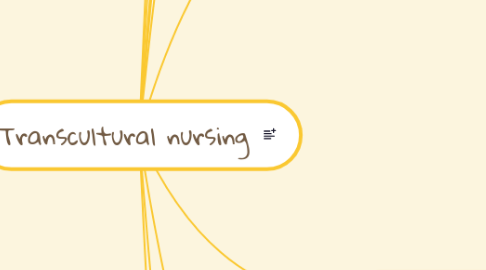
1. Personal/ individual health
2. Florence Nightingale
2.1. ReConstructing hospitals
2.2. Improving basic hygiene
2.3. Public health measures
2.3.1. Providing cleanliness
2.3.2. Wholesome food
2.3.3. Fresh air
2.3.4. Separate people from garage and sweage
2.4. Funding the Nightingale Training School in St. Thomas’ Hosp
3. Five-step problem- solving process
3.1. Care planning
3.2. Implementation
3.3. Evaluation of care plan
4. Madeleine Leininger
4.1. Eight factors influencing TCN
4.1.1. Increasing migration of people
4.1.2. Raising in multicultural identities
4.1.3. Technologies connecting people globally
4.1.4. Global cultural conflicts impacting health care
4.1.5. Increasing people traveling and working in the world
4.1.6. Increasing legal actions
4.1.7. Rising in awareness of gender issues
4.1.8. Increasing demand diverse health care services
4.1.9. Sexual orientation-homophobism
4.2. Sunrise Enabler to discover cultural care
4.2.1. Technological factors
4.2.2. Kinship&social factors
4.2.3. Cultural values, elides,&Lifeways
4.2.4. Political&Legal Factors
4.2.5. Economic factors
4.2.6. Educational factors
4.2.7. Religious&philosophical factors
5. Culturally competence in nursing
5.1. Individual cultural competence
5.1.1. Ten guidelines for the practices
5.1.1.1. Knowledge of culture
5.1.1.2. Education and training
5.1.1.3. Critical reflection
5.1.1.4. Cross-cultural communication
5.1.1.5. Culturally competent practice
5.1.1.6. Cultural competence in health care and organization
5.1.1.7. Multicultural workforce
5.1.1.8. Cross_cultural leadership
5.1.1.9. Evidence-based practice and research
5.1.1.10. Patient advocacy and empowerment
5.1.2. Mutual goal setting
5.2. Organizational cultural competence
6. Transcultural nursing to improve
6.1. Family health
6.2. Group health
6.3. Community health
6.4. Public health
6.5. Institutional health
6.6. Regional health
7. Assessment
7.1. Cultural self- assessment
7.1.1. Self-reflection
7.1.1.1. CSA process
7.1.1.1.1. Race-racism
7.1.1.1.2. Ethnicity-Ethnocentrism
7.1.1.1.3. National origin-Nationalism
7.1.1.1.4. Socioeconomic class-classism
7.1.1.1.5. Gender-sexism, feminism
7.1.1.1.6. Disability-ableism
7.1.1.1.7. Religion
7.1.1.1.8. Political opinion
7.1.1.1.9. Size-seizesm
7.1.2. Self-location
7.1.3. Psychomotor skills
7.2. Client cultural assessment
7.2.1. Health history
7.2.2. Physical exam
8. Self care
8.1. Consumables
8.1.1. Over- the-counter-medicines
8.1.2. Traditional foods
8.1.3. Herbs
8.1.4. Teas
8.1.5. Supplements
8.1.6. Vitamins
8.2. Practices
8.2.1. Spiritual counselors
8.2.2. Rituals
8.2.3. Superstitious habits
8.2.4. Traditions
8.2.5. Folk healers
9. Globalization in transcultural nursing
9.1. Health care disparities
9.1.1. Access
9.1.2. Quality of care
9.1.3. Socioeconomic status
9.2. Cause of death
9.2.1. Communicable diseases
9.2.2. Childbirh
9.2.3. Nutritional deficiencies
9.3. Strategies for overcoming poverty
9.3.1. Awareness
9.3.2. Policy
9.3.3. Community
9.3.4. Advocacy
9.3.5. Participation
9.3.6. Outreach
9.4. Globalization trend
9.4.1. Companionate global nursing
9.4.2. International education
9.4.2.1. Patient satisfaction
9.4.2.2. Cultural competency
9.4.2.3. Patient-nurse relationship
9.4.2.4. Overall quality care
10. Andrews/boyle
10.1. Cultural context
10.1.1. Health-related values
10.1.2. Beliefs
10.1.3. Practices
10.2. Humans worldwide
10.2.1. Inter professional healthcare team

